外研版英语九年级上册 Module 1Wonders of the world Unit 3课件(86张PPT)
文档属性
| 名称 | 外研版英语九年级上册 Module 1Wonders of the world Unit 3课件(86张PPT) |  | |
| 格式 | ppt | ||
| 文件大小 | 63.7MB | ||
| 资源类型 | 教案 | ||
| 版本资源 | 外研版 | ||
| 科目 | 英语 | ||
| 更新时间 | 2023-09-14 11:20:26 | ||
图片预览


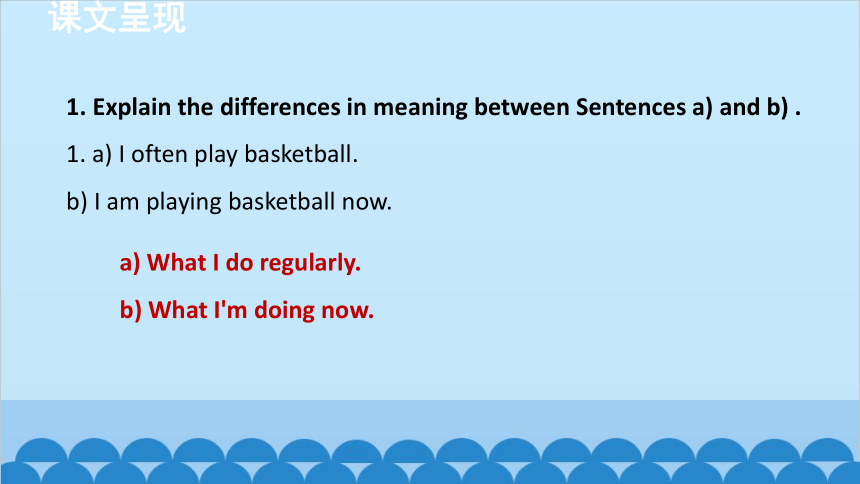


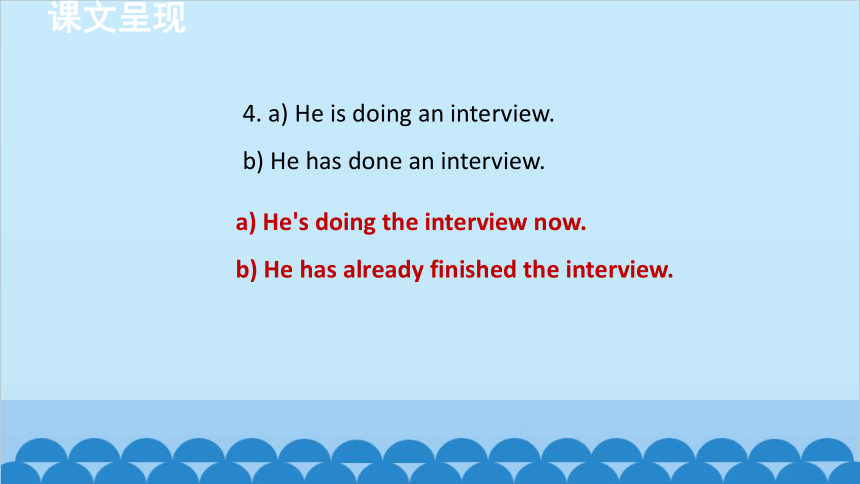
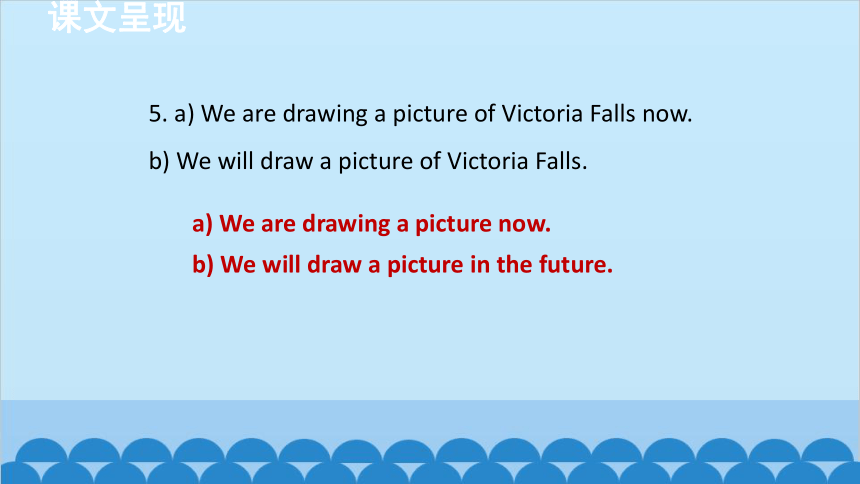
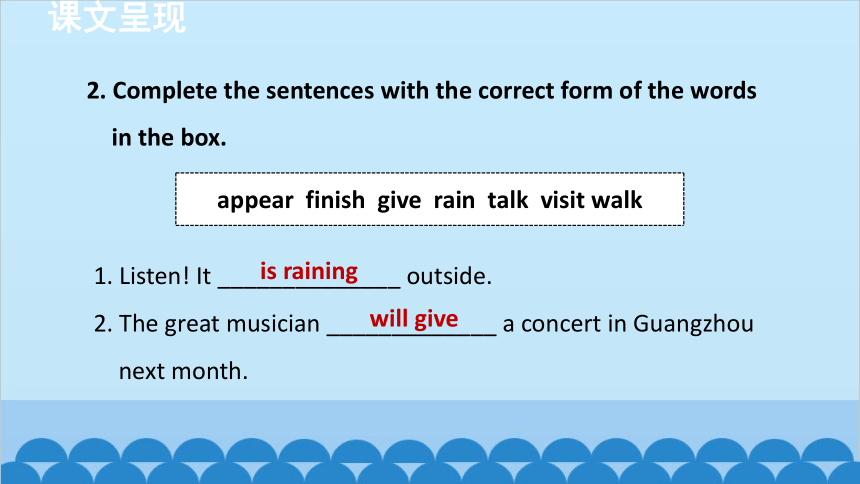

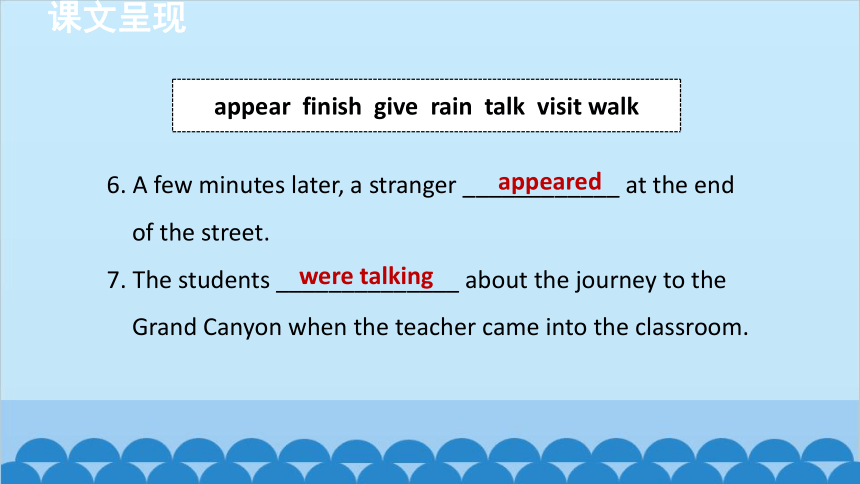
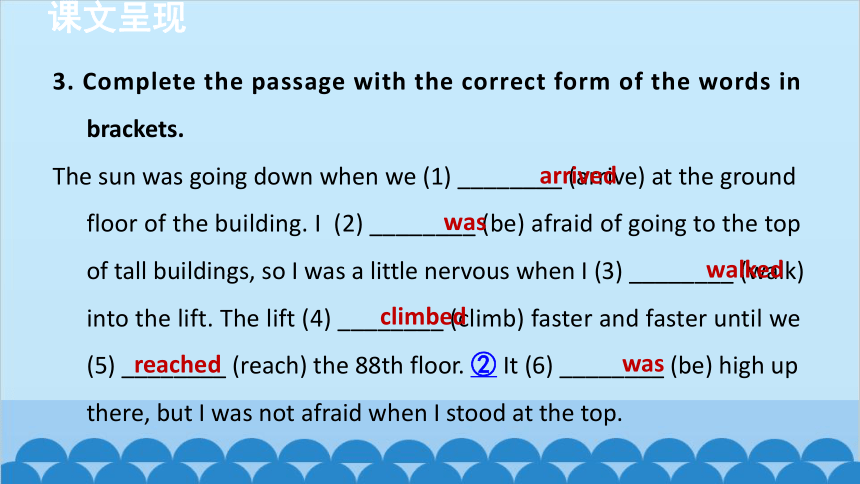
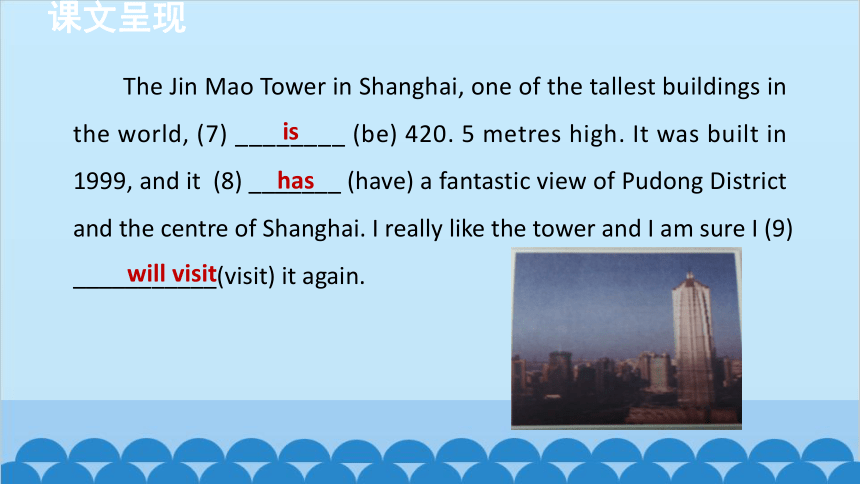
文档简介
(共86张PPT)
同学们, 上一课学习的单词、短语和句型你们都掌握了吗 现在大家来检验一下, 点击下面的音频开始听写吧!
课文呈现
Language practice
I visited the Giant's Causeway two years ago.
It produces electricity for millions of people in China.
I've never seen it, so I'm not sure I agree with you.
I looked to the east—the sky was becoming grey.
You'll get there in five minutes.
Am I going the right way
课文呈现
1. Explain the differences in meaning between Sentences a) and b) .
1. a) I often play basketball.
b) I am playing basketball now.
a) What I do regularly.
b) What I'm doing now.
课文呈现
2. a) She has gone to the Great Wall.
b) She has been to the Great Wall. ①
a) She is still at the Great Wall.
b) She has come back from the Great Wall.
温馨提示: 此符号表示“考点精讲点拨”链接。
课文呈现
3. a) They had an English class yesterday.
b) They were having an English class at nine o'clock yesterday morning.
a) They did it once in the past.
b) They were doing something at a specific time.
课文呈现
4. a) He is doing an interview.
b) He has done an interview.
a) He's doing the interview now.
b) He has already finished the interview.
课文呈现
5. a) We are drawing a picture of Victoria Falls now.
b) We will draw a picture of Victoria Falls.
a) We are drawing a picture now.
b) We will draw a picture in the future.
课文呈现
2. Complete the sentences with the correct form of the words in the box.
appear finish give rain talk visit walk
1. Listen! It ______________ outside.
2. The great musician _____________ a concert in Guangzhou next month.
is raining
will give
课文呈现
appear finish give rain talk visit walk
3. Last summer, my parents ________ the Terracotta Army in Xi'an.
4. He ________ already __________ a new book about travel.
5. Thousands of people ________ along the Great Wall every year.
visited
has
finished
walk
课文呈现
appear finish give rain talk visit walk
6. A few minutes later, a stranger ____________ at the end of the street.
7. The students ______________ about the journey to the Grand Canyon when the teacher came into the classroom.
appeared
were talking
课文呈现
3. Complete the passage with the correct form of the words in brackets.
The sun was going down when we (1) ________ (arrive) at the ground floor of the building. I (2) ________ (be) afraid of going to the top of tall buildings, so I was a little nervous when I (3) ________ (walk) into the lift. The lift (4) ________ (climb) faster and faster until we (5) ________ (reach) the 88th floor. ② It (6) ________ (be) high up there, but I was not afraid when I stood at the top.
arrived
was
walked
climbed
reached
was
课文呈现
The Jin Mao Tower in Shanghai, one of the tallest buildings in the world, (7) ________ (be) 420. 5 metres high. It was built in 1999, and it (8) _______ (have) a fantastic view of Pudong District and the centre of Shanghai. I really like the tower and I am sure I (9) ___________(visit) it again.
will visit
is
has
课文呈现
4. Work in pairs. Talk about the wonders of the world you have or have not visited.
A: Have you ever visited the Great Wall
B: Yes, I have. /No, I haven't.
A: When did you visit it /When will you visit it
B: I visited it five years ago. /Maybe I'll visit it next year.
课文呈现
Now complete the table.
Wonders of the world When did you visit it When will you visit it
The Great Wall
课文呈现
ancient high long natural opinion wonder
5. Complete the sentences with the correct form of the words in the box. There is one extra word.
1. The Changjiang River is about 6, 300 kilometres ________.
2. The Terracotta Army is a famous ________ wonder in China.
long
ancient
课文呈现
3. For my homework I have to write an article about the ___________ of the world.
4. Mount Qomolangma is the ________ mountain in the world.
5. In my ___________, the Great Wall is the greatest man made wonder in the world.
ancient high long natural opinion wonder
wonders
highest
opinion
课文呈现
6. Complete the passage with the expressions in the box.
I'm really (1) ___________________ my visit to the Louvre Museum in Paris. It's the most visited museum in the world—every year, (2) ____________ people visit it. The Louvre is in an old building, but to get inside you must (3) ____________a giant glass pyramid that is (4) __________20 metres tall.
agree with at the bottom of go through
looking forward to③ millions of more than
looking forward to
millions of
go through
more than
课文呈现
The entrance to the museum is (5) __________________ the pyramid. Some people do not like the glass pyramid. They say it looks too new and does not suit the older buildings. I do not (6) _____________ them. I think it looks great!
agree with at the bottom of go through
looking forward to millions of more than
at the bottom of
agree with
课文呈现
7. Listen and number the pictures.
1
2
3
听力材料
One of the natural wonders of the world is Mount Qomolangma, between China and Nepal. It is the highest mountain in the world, at 8, 844. 43 metres. The first people to climb to the top were Sir Edmund Hillary, of New Zealand, and Tenzing Norgay, of Nepal, in 1953.
The Empire State Building in New York in the US is one of the tallest buildings in the world. And it’s also one of the modern wonders.
听力材料
It is 381 metres to the top, and it has 102 floors. Much smaller, although thousands of years older, is the Great Pyramid at Giza in Egypt. It was about 146 metres tall when it was first built. But over the years, it has lost about 9 metres, so it is now about 137 metres tall. It’s about 4, 500 years old, and is one of the ancient wonders of the world.
课文呈现
8. Listen again and complete the table.
Mount Qomolangma The Empire State Building The Great Pyramid at Giza
Location Between China and Nepal _____________ In Egypt
Height ________ metres _______ metres About _______ metres now
Interesting facts First people to climb to the top: Sir Edmund Hillary and Tenzing Norgay ________ floors About ________ years old
8844. 43
In New York
381
102
137
4500
课文呈现
9. Work in pairs. Think about three other wonders of the world and ask and answer questions about them.
A: Where is. . .
B: It's. . .
A: How high is it
B: It's. . . metres high.
课文呈现
Around the world
Stonehenge: a man made wonder of the world
Stonehenge is an ancient circle of stones in the south of England. It is about 5, 000 years old. It was probably a place to bury dead people or a place to study the stars and the sky at night.
There are dozens of stones, and they are different in height. ④The stones came from about 200 kilometres away.
课文呈现
Some of the stones are missing, but it is still one of the most wonderful sights of the world. It is a wonder also because of this question: How did ancient people move these huge stones without machines to help them ⑤ No one knows the answer.
课文呈现
Module task: Make a poster about a wonder of the world.
10. Work in groups of four. Make a poster about a wonder of the world.
· Decide on the wonder of the world for your poster.
·Find out as much information as you can in books and on
websites. Think about:
课文呈现
1. Why should people visit the wonder
2. What will people see there
3. How can people get there
4. How much does it cost to visit the wonder
5 When is the best time to visit the wonder
·Make a poster. Find some pictures showing the wonder.
课文呈现
11. Present your poster to the class.
①She has been to the Great Wall.
have/has been to 去过
考点1
辨析:have/has gone to, have/has been to 与have/has been in
have/has gone to 意为“去了......”, 强调主语去了某地, 还没回来, 可能在去某地的路上, 也可能已经到达。
have/has been/gone to 都不能与一段时间连用。
have/has been to 意为“去过”, 强调主语曾经去过某地, 现在已经回来了, 可与表示次数的词(如once, twice, three times 等) 或never, ever 等连用。
have/has
been in “have/has been in+ 地点名词”表示“在某地(已经多长时间) ”, 常与“for+ 一段时间”连用。其后接地点副词时, 则去掉介词in。
e.g. —The Whites have gone to Hong Kong.
怀特一家去香港了。
—Really I have never been there before.
真的吗?我以前从没有去过那儿。
He has been in Shanghai for 7 years.
他来上海七年了。
there 为地点副词, 其前不带to。
考题在线1:—Where is Lucy I haven’t seen her for days.
—She ________ Chengdu. She’ll be back next week. [泸州]
A. has gone to B. has been to
C. have gone to D. have been to
A
考题在线2:—Miss Zhang seems quite familiar with Yunnan Province.
—Don’t you know She _______ a town school there as a volunteer teacher for over 2 years. [南通]
A. is in B. has gone to
C. has been in D. has been to
C
【点拨】时间状语提示用现在完成时态, 易混项has gone to 表示“去某地了”, has been to 表示“去过某地”都不能和表示一段时间的时间状语连用。
返回
温馨提示:可返回原文
②The lift (4) _____ (climb) faster and faster until we (5) _____ (reach) the 88th floor.
faster and faster 越来越快
e.g. Our life is becoming better and better.
我们的生活正变得越来越好。
Beijing is becoming more and more beautiful.
北京正变得越来越漂亮。
考点2
“比较级+and+ 比较级”意为“越来越……”, 多音节词用“more and more+原级”。
The earlier kids learn to be independent, the better it is for their future.
孩子们越早学会独立, 对他们的未来越好。
“the+ 比较级,the+比较级”表示一方的程度随着另一方的变化而变化,意为“越……,就会越…
考题在线3:People in the rural areas live a _______ life with the care of the government. [恩施]
A. happier and happier B. poorer and poorer
C. more and more happily
A
返回
③looking forward to
look forward to 期望
e.g. I’m looking forward to hearing from him.
我正盼望收到他的来信。
考点3
to 是介词,后接名词、动名词或代词。
接动名词的短语:
pay attention to 留心……
get/be used to 习惯于……
stick to 坚持……
lead to 导致
be busy doing 忙于做……
give up doing 放弃做……
be worth doing 值得做……
feel like doing 想做……
keep on doing 继续做……
考题在线4:我正期待着收到你的来信。
I’m looking forward ___________________ you. [朝阳]
to hearing from
返回
④There are dozens of stones, and they are different in height.
dozens of 几十个;许多;dozen 是名词, 意为“一打(12 个) ”。
e.g. We collected dozens of shells on the beach.
我们在沙滩上捡了数十枚贝壳。
考点4
特别提醒 : ① dozen 前有具体数字时, 要用单数。
② dozen 前没有具体数字时, 要用复数, 且要与of 连用。
返回
⑤It is a wonder also because of this question...
because of 因为
e.g. I was tired because of working too late last night.
我很疲惫, 因为昨天晚上工作太晚。
He was late because he missed the early bus.
因为错过了早班车, 所以他迟到了。
考点5
不同的“因为”
because of, 介词短语,后跟名词或名词短语
because,连词,引导
考题在线5:And ___________ _________ the bad weather, we couldn’t see anything below. 因为天气糟糕, 山底下的东西我们什么也看不到。 [枣庄]
because of
返回
一般现在时
考点1
时态复习
用法:
①用来表述或说明某一事物的特征。
e.g. I think the Great Wall is fantastic.
我认为长城很壮观。
考向1
② 还表示经常发生的动作、存在的状态、习惯性动作或客观真理、科学事实等。
e. g. The sun rises in the east. 太阳从东方升起。
时间状语:often, usually, always, sometimes, every day/week/ month/year..., once a week, on Sundays 等。
用法:基本结构
考向2
肯定句 主语+be(am/is/are) + 其他. 主语+行为动词原形/第三人称单数形式+其他.
否定句 主语+am/is/are+not+ 其他. 主语+don’t/doesn’t+
动词原形+其他.
一般疑问句及答语 Be(Am/Is/Are) +主语+ 其他?肯定回答:Yes, 主语+am/is/are. 否定回答:No, I’m not./No, 主语+ isn’t/aren’t. Do/Does + 主语+ 动词原形+ 其他?肯定回答:Yes, 主语+do/does. 否定回答:No, 主语+don’t/doesn’t.
小贴士 表示客观事实或普遍真理,用一般现在时,此用法如果出现在宾语从句中,即使主句是过去时态,从句也要用一般现在时。
考题在线1:Mid-Autumn Day usually _______ on August 15th in the lunar calendar (阴历) every year. [十堰]
A. come B. comes
C. is coming D. will come
B
【点拨】根据时间状语every year 可知, 此处应用一般现在时;主语是Mid-Autumn Day, 为单数, come 应用第三
人称单数形式。
一般过去时
考点2
用法:①表示过去某个时间发生的动作或存在的状态。
e. g. I got up at six thirty yesterday morning.
我昨天早上六点半起床。
考向1
②表示过去经常或反复发生的动作。
e. g. When I was a child, I often listened to music.
当我是个孩子的时候, 我经常听音乐。
时间状语: ago, yesterday, the day before yesterday, last night/week/ month/year..., in 1989, just now, once upon a time 等。
用法:基本结构
考向2
肯定句 主语+was/were+ 其他. 主语+ 动词的过去式+ 其他.
否定句 主语+was/were+not+ 其他. 主语+didn’t+ 动词原形+ 其他.
一般疑问句及答语 Was/Were+主语+其他?肯定回答:Yes, 主语+was/were. 否定回答:No, 主语+wasn’t/ weren’t. Did+ 主语+ 动词原形+ 其他?肯定回答:Yes, 主语+did. 否定回答:No, 主语+didn’t.
考题在线2:—Have you ever visited Shenyang EXPO Garden
—Yes. I ______ it last year. [牡丹江]
A. have visited B. will visit C. visited
【点拨】根据答句中的last year, 可知答句是一般过去时, 动词应用过去式。
C
速记小法:
一般过去时并不难,过去发生的事情记心间。主要句型“主谓宾”,“主系表”结构也常见。
“主谓宾”否定很简单,didn’t 放在主谓间。
“主系表”否定也不难,was/were 后not紧相连。
“主谓宾”变成疑问句,did 放在主语前。
“主系表”疑问也好办,was/were 提到主语前。
疑问、否定随你变,行为动词过去式要还原。
现在进行时
考点3
用法:表示现在或现阶段正在进行或发生的动作。
e. g. He is watching a movie now. 他现在正在看电影。
标志词:now, at this time, these days, at the moment, look, listen 等。
考向1
用法:基本结构
考向2
肯定句 主语+am/is/are+v.-ing +其他.
否定句 主语+am/is/are+not+v.-ing +其他.
一般疑问句及答语 Am/Is/Are +主语+v.-ing +其他?
肯定回答:Yes, 主语+am/is/are.
否定回答:No, I’m not. /No, 主语+isn’t. /No, 主语+aren’t.
考题在线3:—Peter, what are you doing
—Oh, I _______ a report about national heroes. [北京]
A. will write B. am writing
C. wrote D. have written
【点拨】根据问句中“what are you doing ”可知, 此处强调动作正在发生, 使用现在进行时。
B
过去进行时
考点4
用法:表示过去某个时刻或某段时间内正在进行的动作。
e. g. They were having breakfast at 7:00 am yesterday.
昨天上午七点钟, 他们正在吃早餐。
From 1983 to 1998, he was teaching in Beijing.
从1983 年到1998 年, 他一直在北京教学。
考向1
时间状语:at this time yesterday, at that time 或用在以when 和while 引导的时间状语从句中。
用法:基本结构
考向2
肯定句 主语+was/were+v.-ing+ 其他.
否定句 主语+was/were not+v.-ing+ 其他.
一般疑问句及答语 Was/Were+ 主语+v.-ing+其他?
肯定回答:Yes, 主语+ was/were.
否定回答:No, 主语+wasn’t/weren’t.
考题在线4:—Did you see Dorothy She just came back from abroad.
—Yes. But she _______ someone, so I nodded to her and went away. [呼和浩特、包头]
A. phones B. is phoning
C. was phoning D. has phoned
【点拨】答语表示我看到Dorothy 时她在打电话, 过去时刻正在发生的动作用过去进行时表示。
C
一般将来时
考点5
用法:表示将要发生的动作或存在的状态及打算、计划或准备做某事。
e.g. What are you going to do tomorrow
你明天准备做什么?
时间状语:tomorrow, next day/week/month/year..., soon, in a few minutes 等。
考向1
用法:基本结构
考向2
肯定句 主语+will/shall+动词原形+ 其他.(shall 用于第一人称) 主语+be(am/is/are) going to+ 动词原形+ 其他.
否定句 主语+will/shallnot+ 动词原形+其他. 主语+be(am/is/are) not going to+ 动词原形+其他.
一般疑问句及答语 Will/Shall+主语+动词原形+ 其他?肯定回答:Yes, 主语+will/shall.否定回答:No, 主语+won’t /shan’t. Be(Am/Is/Are) + 主语+going to+ 动词原形+ 其他?肯定回答:Yes, 主语+ am/is/are.否定回答:No, I’m not./No, 主语+ isn’t./No, 主语+aren’t.
辨析:will 与be going to
be going to 指按计划将要发生的事;will 强调主观意识。
考题在线5:You can borrow this film— surely you ________ watching it. [河北]
A. enjoy B. enjoyed
C. will enjoy D. have enjoyed
【点拨】分析“You can borrow this film—surely you... watching it.” 可知, 此处动作还未发生, 用一般将来时。
C
一般将来时的特殊用法:
① go, come, leave 等用现在进行时表示按计划、安排将要发生的动作。
e.g. I’m leaving tomorrow. 我明天走。
考向3
② if 引导宾语从句, 意为“是否”, 时态受主句影响。
③if 引导条件状语从句, 意为“如果”, 时态遵循“主将从现”原则。
e.g. —Could you tell me if Jim is going to have a party tomorrow
你能告诉我吉姆明天是否打算举行聚会
—If he has a party tomorrow, I’ll tell you.
如果明天他举行聚会, 我将告诉你。
考题在线6:—I wonder if Li Hua ______ to the hospital to receive COVID-19 vaccinations(疫苗接种).
—I ’ m sure he will if he time. [达州]
A. goes; will have B. will go; has
C. will go; will have D. goes; has
【点拨】第一个if 引导的是宾语从句, 从语境可知动作还未发生, 用一般将来时;第二个if 引导的是条件状语从句, 根据主将从现的原则可知第二空为一般现在时。
B
现在完成时
考点6
用法:
① 表示过去发生或已经完成的动作对现在造成的影响或结果;
② 表示从过去已经开始, 持续到现在的动作或状态, 甚至还可能继续下去, 句中使用延续性动词, 且常有表示一段时间的时间状语。
考向1
e. g. We haven’t seen each other for ten years.
我们已经10 年没有见面了。
时间状语:just, already, yet, ever, never, recently, lately, since..., so far, for..., in the past few years 等。
用法:基本结构
考向2
肯定句 主语+have/has+ 过去分词+ 其他.
否定句 主语+haven’t/hasn’t+ 过去分词+其他.
一般疑问句及答语 Have/Has+主语+过去分词+其他?
肯定回答:Yes, 主语+have/has.
否定回答:No, 主语+haven’t/hasn’t.
考题在线7:—What good books did you read recently
—I ________ Tales of China since last year, and now the third time. [武汉]
A. read B. am reading
C. have read D. will read
【点拨】由since last year可知, 此处应用现在完成时态。
C
(岳阳改编) 根据《中国美好生活大调查》结果, 我们的家乡岳阳荣获“中国美好生活城市十大心仪之城”的称号, 是湖南省唯一入选的地级市。家乡, 一个你成长的地方, 请你根据下面的图表信息, 以“My Hometown—Yueyang”为题, 写一篇英语短文向别人介绍你的家乡岳阳。
模块话题
要求:
1. 词数80~100;2. 请根据以上提示信息, 结合实际情况叙述, 可适当发挥;3. 文稿中不得出现真实的人名、校名;4. 字迹工整, 语言流畅, 表达正确, 逻辑清晰。
审题指导
体裁 说明文 时态 一般现在时
话题 介绍城市 人称 第三人称
段落布局 开头: 开门见山, 介绍岳阳市
主体: 介绍岳阳市的地理位置、面积、人口、历史、气候、环境、名胜及美食。
结尾: 盛情邀请前来旅行
写作方法
“三环节法”介绍家乡城市:①开篇点题→②按合理的顺序具体介绍或分层介绍→③表达感情并盛情邀请
写作模板
开篇
点题 Yueyang is one of the top ten favorite cities in China.
具体
介绍 位置&面积 It is located..., covering...
人口&历史 It has a population of... Yueyang has a history of...
气候&环境 There are four... Yueyang is a place with...
名胜&美食 There are also . . . Yueyang also has ...
盛情邀请 Do you like ...
Welcome to visit ...
经典词句
单词 cover, square, kilometer, million, over, with, fresh, clean, also
短语 in the northeast of, a population of, many places to visit, such as, a lot of, and so on
句型 ① Yueyang is one of the top ten favorite cities in China.
② It is located in ..., covering about ... square kilometers.
③ Yueyang has a history of over 2, 500 years.
④ There are four di f ferent seasons in Yueyang.
⑤ Welcome to visit my hometown.
范文赏析
My Hometown — Yueyang
Yueyang is one of the top ten favorite cities in China. It is located in the northeast of Hunan, covering about 14, 858 square kilometers. It has a population of about 5.05 million. Yueyang has a history of over 2, 500 years. There are four different seasons in Yueyang. Yueyang is a place with fresh air and clean water.
There are also many places to visit, such as Dongting Lake and Yueyang Tower. Yueyang also has a lot of good things to eat. You can eat fish, rice, crayfish and so on.
Do you like my hometown Welcome to visit my hometown.
名师点评
本文运用了“ 三环节法” 介绍家乡岳阳。第一环节:开篇点题, 点明岳阳的城市地位;第二环节:具体介绍(围绕位置、面积、人口、历史、气候、环境、名胜及美食) 岳阳, 提升了其旅游价值;第三环节:盛情邀请, 体现了作者对家乡的热爱之情。如此谋篇使文章结构清晰, 条理分明。
添彩点:文中灵活运用了in the northeast of, a population of, such as, and so on 等短语, 让语言更加优美, 表达更加贴切。文中的句式多变, 如 It is located... 被动语态的使用、动词
本节课主要学习了:
六种基本时态的比较;练习动词(短语) 在句中正确的时态应用;更多的了解世界景观, 并学会将其中一个做出海报。
同学们, 上一课学习的单词、短语和句型你们都掌握了吗 现在大家来检验一下, 点击下面的音频开始听写吧!
课文呈现
Language practice
I visited the Giant's Causeway two years ago.
It produces electricity for millions of people in China.
I've never seen it, so I'm not sure I agree with you.
I looked to the east—the sky was becoming grey.
You'll get there in five minutes.
Am I going the right way
课文呈现
1. Explain the differences in meaning between Sentences a) and b) .
1. a) I often play basketball.
b) I am playing basketball now.
a) What I do regularly.
b) What I'm doing now.
课文呈现
2. a) She has gone to the Great Wall.
b) She has been to the Great Wall. ①
a) She is still at the Great Wall.
b) She has come back from the Great Wall.
温馨提示: 此符号表示“考点精讲点拨”链接。
课文呈现
3. a) They had an English class yesterday.
b) They were having an English class at nine o'clock yesterday morning.
a) They did it once in the past.
b) They were doing something at a specific time.
课文呈现
4. a) He is doing an interview.
b) He has done an interview.
a) He's doing the interview now.
b) He has already finished the interview.
课文呈现
5. a) We are drawing a picture of Victoria Falls now.
b) We will draw a picture of Victoria Falls.
a) We are drawing a picture now.
b) We will draw a picture in the future.
课文呈现
2. Complete the sentences with the correct form of the words in the box.
appear finish give rain talk visit walk
1. Listen! It ______________ outside.
2. The great musician _____________ a concert in Guangzhou next month.
is raining
will give
课文呈现
appear finish give rain talk visit walk
3. Last summer, my parents ________ the Terracotta Army in Xi'an.
4. He ________ already __________ a new book about travel.
5. Thousands of people ________ along the Great Wall every year.
visited
has
finished
walk
课文呈现
appear finish give rain talk visit walk
6. A few minutes later, a stranger ____________ at the end of the street.
7. The students ______________ about the journey to the Grand Canyon when the teacher came into the classroom.
appeared
were talking
课文呈现
3. Complete the passage with the correct form of the words in brackets.
The sun was going down when we (1) ________ (arrive) at the ground floor of the building. I (2) ________ (be) afraid of going to the top of tall buildings, so I was a little nervous when I (3) ________ (walk) into the lift. The lift (4) ________ (climb) faster and faster until we (5) ________ (reach) the 88th floor. ② It (6) ________ (be) high up there, but I was not afraid when I stood at the top.
arrived
was
walked
climbed
reached
was
课文呈现
The Jin Mao Tower in Shanghai, one of the tallest buildings in the world, (7) ________ (be) 420. 5 metres high. It was built in 1999, and it (8) _______ (have) a fantastic view of Pudong District and the centre of Shanghai. I really like the tower and I am sure I (9) ___________(visit) it again.
will visit
is
has
课文呈现
4. Work in pairs. Talk about the wonders of the world you have or have not visited.
A: Have you ever visited the Great Wall
B: Yes, I have. /No, I haven't.
A: When did you visit it /When will you visit it
B: I visited it five years ago. /Maybe I'll visit it next year.
课文呈现
Now complete the table.
Wonders of the world When did you visit it When will you visit it
The Great Wall
课文呈现
ancient high long natural opinion wonder
5. Complete the sentences with the correct form of the words in the box. There is one extra word.
1. The Changjiang River is about 6, 300 kilometres ________.
2. The Terracotta Army is a famous ________ wonder in China.
long
ancient
课文呈现
3. For my homework I have to write an article about the ___________ of the world.
4. Mount Qomolangma is the ________ mountain in the world.
5. In my ___________, the Great Wall is the greatest man made wonder in the world.
ancient high long natural opinion wonder
wonders
highest
opinion
课文呈现
6. Complete the passage with the expressions in the box.
I'm really (1) ___________________ my visit to the Louvre Museum in Paris. It's the most visited museum in the world—every year, (2) ____________ people visit it. The Louvre is in an old building, but to get inside you must (3) ____________a giant glass pyramid that is (4) __________20 metres tall.
agree with at the bottom of go through
looking forward to③ millions of more than
looking forward to
millions of
go through
more than
课文呈现
The entrance to the museum is (5) __________________ the pyramid. Some people do not like the glass pyramid. They say it looks too new and does not suit the older buildings. I do not (6) _____________ them. I think it looks great!
agree with at the bottom of go through
looking forward to millions of more than
at the bottom of
agree with
课文呈现
7. Listen and number the pictures.
1
2
3
听力材料
One of the natural wonders of the world is Mount Qomolangma, between China and Nepal. It is the highest mountain in the world, at 8, 844. 43 metres. The first people to climb to the top were Sir Edmund Hillary, of New Zealand, and Tenzing Norgay, of Nepal, in 1953.
The Empire State Building in New York in the US is one of the tallest buildings in the world. And it’s also one of the modern wonders.
听力材料
It is 381 metres to the top, and it has 102 floors. Much smaller, although thousands of years older, is the Great Pyramid at Giza in Egypt. It was about 146 metres tall when it was first built. But over the years, it has lost about 9 metres, so it is now about 137 metres tall. It’s about 4, 500 years old, and is one of the ancient wonders of the world.
课文呈现
8. Listen again and complete the table.
Mount Qomolangma The Empire State Building The Great Pyramid at Giza
Location Between China and Nepal _____________ In Egypt
Height ________ metres _______ metres About _______ metres now
Interesting facts First people to climb to the top: Sir Edmund Hillary and Tenzing Norgay ________ floors About ________ years old
8844. 43
In New York
381
102
137
4500
课文呈现
9. Work in pairs. Think about three other wonders of the world and ask and answer questions about them.
A: Where is. . .
B: It's. . .
A: How high is it
B: It's. . . metres high.
课文呈现
Around the world
Stonehenge: a man made wonder of the world
Stonehenge is an ancient circle of stones in the south of England. It is about 5, 000 years old. It was probably a place to bury dead people or a place to study the stars and the sky at night.
There are dozens of stones, and they are different in height. ④The stones came from about 200 kilometres away.
课文呈现
Some of the stones are missing, but it is still one of the most wonderful sights of the world. It is a wonder also because of this question: How did ancient people move these huge stones without machines to help them ⑤ No one knows the answer.
课文呈现
Module task: Make a poster about a wonder of the world.
10. Work in groups of four. Make a poster about a wonder of the world.
· Decide on the wonder of the world for your poster.
·Find out as much information as you can in books and on
websites. Think about:
课文呈现
1. Why should people visit the wonder
2. What will people see there
3. How can people get there
4. How much does it cost to visit the wonder
5 When is the best time to visit the wonder
·Make a poster. Find some pictures showing the wonder.
课文呈现
11. Present your poster to the class.
①She has been to the Great Wall.
have/has been to 去过
考点1
辨析:have/has gone to, have/has been to 与have/has been in
have/has gone to 意为“去了......”, 强调主语去了某地, 还没回来, 可能在去某地的路上, 也可能已经到达。
have/has been/gone to 都不能与一段时间连用。
have/has been to 意为“去过”, 强调主语曾经去过某地, 现在已经回来了, 可与表示次数的词(如once, twice, three times 等) 或never, ever 等连用。
have/has
been in “have/has been in+ 地点名词”表示“在某地(已经多长时间) ”, 常与“for+ 一段时间”连用。其后接地点副词时, 则去掉介词in。
e.g. —The Whites have gone to Hong Kong.
怀特一家去香港了。
—Really I have never been there before.
真的吗?我以前从没有去过那儿。
He has been in Shanghai for 7 years.
他来上海七年了。
there 为地点副词, 其前不带to。
考题在线1:—Where is Lucy I haven’t seen her for days.
—She ________ Chengdu. She’ll be back next week. [泸州]
A. has gone to B. has been to
C. have gone to D. have been to
A
考题在线2:—Miss Zhang seems quite familiar with Yunnan Province.
—Don’t you know She _______ a town school there as a volunteer teacher for over 2 years. [南通]
A. is in B. has gone to
C. has been in D. has been to
C
【点拨】时间状语提示用现在完成时态, 易混项has gone to 表示“去某地了”, has been to 表示“去过某地”都不能和表示一段时间的时间状语连用。
返回
温馨提示:可返回原文
②The lift (4) _____ (climb) faster and faster until we (5) _____ (reach) the 88th floor.
faster and faster 越来越快
e.g. Our life is becoming better and better.
我们的生活正变得越来越好。
Beijing is becoming more and more beautiful.
北京正变得越来越漂亮。
考点2
“比较级+and+ 比较级”意为“越来越……”, 多音节词用“more and more+原级”。
The earlier kids learn to be independent, the better it is for their future.
孩子们越早学会独立, 对他们的未来越好。
“the+ 比较级,the+比较级”表示一方的程度随着另一方的变化而变化,意为“越……,就会越…
考题在线3:People in the rural areas live a _______ life with the care of the government. [恩施]
A. happier and happier B. poorer and poorer
C. more and more happily
A
返回
③looking forward to
look forward to 期望
e.g. I’m looking forward to hearing from him.
我正盼望收到他的来信。
考点3
to 是介词,后接名词、动名词或代词。
接动名词的短语:
pay attention to 留心……
get/be used to 习惯于……
stick to 坚持……
lead to 导致
be busy doing 忙于做……
give up doing 放弃做……
be worth doing 值得做……
feel like doing 想做……
keep on doing 继续做……
考题在线4:我正期待着收到你的来信。
I’m looking forward ___________________ you. [朝阳]
to hearing from
返回
④There are dozens of stones, and they are different in height.
dozens of 几十个;许多;dozen 是名词, 意为“一打(12 个) ”。
e.g. We collected dozens of shells on the beach.
我们在沙滩上捡了数十枚贝壳。
考点4
特别提醒 : ① dozen 前有具体数字时, 要用单数。
② dozen 前没有具体数字时, 要用复数, 且要与of 连用。
返回
⑤It is a wonder also because of this question...
because of 因为
e.g. I was tired because of working too late last night.
我很疲惫, 因为昨天晚上工作太晚。
He was late because he missed the early bus.
因为错过了早班车, 所以他迟到了。
考点5
不同的“因为”
because of, 介词短语,后跟名词或名词短语
because,连词,引导
考题在线5:And ___________ _________ the bad weather, we couldn’t see anything below. 因为天气糟糕, 山底下的东西我们什么也看不到。 [枣庄]
because of
返回
一般现在时
考点1
时态复习
用法:
①用来表述或说明某一事物的特征。
e.g. I think the Great Wall is fantastic.
我认为长城很壮观。
考向1
② 还表示经常发生的动作、存在的状态、习惯性动作或客观真理、科学事实等。
e. g. The sun rises in the east. 太阳从东方升起。
时间状语:often, usually, always, sometimes, every day/week/ month/year..., once a week, on Sundays 等。
用法:基本结构
考向2
肯定句 主语+be(am/is/are) + 其他. 主语+行为动词原形/第三人称单数形式+其他.
否定句 主语+am/is/are+not+ 其他. 主语+don’t/doesn’t+
动词原形+其他.
一般疑问句及答语 Be(Am/Is/Are) +主语+ 其他?肯定回答:Yes, 主语+am/is/are. 否定回答:No, I’m not./No, 主语+ isn’t/aren’t. Do/Does + 主语+ 动词原形+ 其他?肯定回答:Yes, 主语+do/does. 否定回答:No, 主语+don’t/doesn’t.
小贴士 表示客观事实或普遍真理,用一般现在时,此用法如果出现在宾语从句中,即使主句是过去时态,从句也要用一般现在时。
考题在线1:Mid-Autumn Day usually _______ on August 15th in the lunar calendar (阴历) every year. [十堰]
A. come B. comes
C. is coming D. will come
B
【点拨】根据时间状语every year 可知, 此处应用一般现在时;主语是Mid-Autumn Day, 为单数, come 应用第三
人称单数形式。
一般过去时
考点2
用法:①表示过去某个时间发生的动作或存在的状态。
e. g. I got up at six thirty yesterday morning.
我昨天早上六点半起床。
考向1
②表示过去经常或反复发生的动作。
e. g. When I was a child, I often listened to music.
当我是个孩子的时候, 我经常听音乐。
时间状语: ago, yesterday, the day before yesterday, last night/week/ month/year..., in 1989, just now, once upon a time 等。
用法:基本结构
考向2
肯定句 主语+was/were+ 其他. 主语+ 动词的过去式+ 其他.
否定句 主语+was/were+not+ 其他. 主语+didn’t+ 动词原形+ 其他.
一般疑问句及答语 Was/Were+主语+其他?肯定回答:Yes, 主语+was/were. 否定回答:No, 主语+wasn’t/ weren’t. Did+ 主语+ 动词原形+ 其他?肯定回答:Yes, 主语+did. 否定回答:No, 主语+didn’t.
考题在线2:—Have you ever visited Shenyang EXPO Garden
—Yes. I ______ it last year. [牡丹江]
A. have visited B. will visit C. visited
【点拨】根据答句中的last year, 可知答句是一般过去时, 动词应用过去式。
C
速记小法:
一般过去时并不难,过去发生的事情记心间。主要句型“主谓宾”,“主系表”结构也常见。
“主谓宾”否定很简单,didn’t 放在主谓间。
“主系表”否定也不难,was/were 后not紧相连。
“主谓宾”变成疑问句,did 放在主语前。
“主系表”疑问也好办,was/were 提到主语前。
疑问、否定随你变,行为动词过去式要还原。
现在进行时
考点3
用法:表示现在或现阶段正在进行或发生的动作。
e. g. He is watching a movie now. 他现在正在看电影。
标志词:now, at this time, these days, at the moment, look, listen 等。
考向1
用法:基本结构
考向2
肯定句 主语+am/is/are+v.-ing +其他.
否定句 主语+am/is/are+not+v.-ing +其他.
一般疑问句及答语 Am/Is/Are +主语+v.-ing +其他?
肯定回答:Yes, 主语+am/is/are.
否定回答:No, I’m not. /No, 主语+isn’t. /No, 主语+aren’t.
考题在线3:—Peter, what are you doing
—Oh, I _______ a report about national heroes. [北京]
A. will write B. am writing
C. wrote D. have written
【点拨】根据问句中“what are you doing ”可知, 此处强调动作正在发生, 使用现在进行时。
B
过去进行时
考点4
用法:表示过去某个时刻或某段时间内正在进行的动作。
e. g. They were having breakfast at 7:00 am yesterday.
昨天上午七点钟, 他们正在吃早餐。
From 1983 to 1998, he was teaching in Beijing.
从1983 年到1998 年, 他一直在北京教学。
考向1
时间状语:at this time yesterday, at that time 或用在以when 和while 引导的时间状语从句中。
用法:基本结构
考向2
肯定句 主语+was/were+v.-ing+ 其他.
否定句 主语+was/were not+v.-ing+ 其他.
一般疑问句及答语 Was/Were+ 主语+v.-ing+其他?
肯定回答:Yes, 主语+ was/were.
否定回答:No, 主语+wasn’t/weren’t.
考题在线4:—Did you see Dorothy She just came back from abroad.
—Yes. But she _______ someone, so I nodded to her and went away. [呼和浩特、包头]
A. phones B. is phoning
C. was phoning D. has phoned
【点拨】答语表示我看到Dorothy 时她在打电话, 过去时刻正在发生的动作用过去进行时表示。
C
一般将来时
考点5
用法:表示将要发生的动作或存在的状态及打算、计划或准备做某事。
e.g. What are you going to do tomorrow
你明天准备做什么?
时间状语:tomorrow, next day/week/month/year..., soon, in a few minutes 等。
考向1
用法:基本结构
考向2
肯定句 主语+will/shall+动词原形+ 其他.(shall 用于第一人称) 主语+be(am/is/are) going to+ 动词原形+ 其他.
否定句 主语+will/shallnot+ 动词原形+其他. 主语+be(am/is/are) not going to+ 动词原形+其他.
一般疑问句及答语 Will/Shall+主语+动词原形+ 其他?肯定回答:Yes, 主语+will/shall.否定回答:No, 主语+won’t /shan’t. Be(Am/Is/Are) + 主语+going to+ 动词原形+ 其他?肯定回答:Yes, 主语+ am/is/are.否定回答:No, I’m not./No, 主语+ isn’t./No, 主语+aren’t.
辨析:will 与be going to
be going to 指按计划将要发生的事;will 强调主观意识。
考题在线5:You can borrow this film— surely you ________ watching it. [河北]
A. enjoy B. enjoyed
C. will enjoy D. have enjoyed
【点拨】分析“You can borrow this film—surely you... watching it.” 可知, 此处动作还未发生, 用一般将来时。
C
一般将来时的特殊用法:
① go, come, leave 等用现在进行时表示按计划、安排将要发生的动作。
e.g. I’m leaving tomorrow. 我明天走。
考向3
② if 引导宾语从句, 意为“是否”, 时态受主句影响。
③if 引导条件状语从句, 意为“如果”, 时态遵循“主将从现”原则。
e.g. —Could you tell me if Jim is going to have a party tomorrow
你能告诉我吉姆明天是否打算举行聚会
—If he has a party tomorrow, I’ll tell you.
如果明天他举行聚会, 我将告诉你。
考题在线6:—I wonder if Li Hua ______ to the hospital to receive COVID-19 vaccinations(疫苗接种).
—I ’ m sure he will if he time. [达州]
A. goes; will have B. will go; has
C. will go; will have D. goes; has
【点拨】第一个if 引导的是宾语从句, 从语境可知动作还未发生, 用一般将来时;第二个if 引导的是条件状语从句, 根据主将从现的原则可知第二空为一般现在时。
B
现在完成时
考点6
用法:
① 表示过去发生或已经完成的动作对现在造成的影响或结果;
② 表示从过去已经开始, 持续到现在的动作或状态, 甚至还可能继续下去, 句中使用延续性动词, 且常有表示一段时间的时间状语。
考向1
e. g. We haven’t seen each other for ten years.
我们已经10 年没有见面了。
时间状语:just, already, yet, ever, never, recently, lately, since..., so far, for..., in the past few years 等。
用法:基本结构
考向2
肯定句 主语+have/has+ 过去分词+ 其他.
否定句 主语+haven’t/hasn’t+ 过去分词+其他.
一般疑问句及答语 Have/Has+主语+过去分词+其他?
肯定回答:Yes, 主语+have/has.
否定回答:No, 主语+haven’t/hasn’t.
考题在线7:—What good books did you read recently
—I ________ Tales of China since last year, and now the third time. [武汉]
A. read B. am reading
C. have read D. will read
【点拨】由since last year可知, 此处应用现在完成时态。
C
(岳阳改编) 根据《中国美好生活大调查》结果, 我们的家乡岳阳荣获“中国美好生活城市十大心仪之城”的称号, 是湖南省唯一入选的地级市。家乡, 一个你成长的地方, 请你根据下面的图表信息, 以“My Hometown—Yueyang”为题, 写一篇英语短文向别人介绍你的家乡岳阳。
模块话题
要求:
1. 词数80~100;2. 请根据以上提示信息, 结合实际情况叙述, 可适当发挥;3. 文稿中不得出现真实的人名、校名;4. 字迹工整, 语言流畅, 表达正确, 逻辑清晰。
审题指导
体裁 说明文 时态 一般现在时
话题 介绍城市 人称 第三人称
段落布局 开头: 开门见山, 介绍岳阳市
主体: 介绍岳阳市的地理位置、面积、人口、历史、气候、环境、名胜及美食。
结尾: 盛情邀请前来旅行
写作方法
“三环节法”介绍家乡城市:①开篇点题→②按合理的顺序具体介绍或分层介绍→③表达感情并盛情邀请
写作模板
开篇
点题 Yueyang is one of the top ten favorite cities in China.
具体
介绍 位置&面积 It is located..., covering...
人口&历史 It has a population of... Yueyang has a history of...
气候&环境 There are four... Yueyang is a place with...
名胜&美食 There are also . . . Yueyang also has ...
盛情邀请 Do you like ...
Welcome to visit ...
经典词句
单词 cover, square, kilometer, million, over, with, fresh, clean, also
短语 in the northeast of, a population of, many places to visit, such as, a lot of, and so on
句型 ① Yueyang is one of the top ten favorite cities in China.
② It is located in ..., covering about ... square kilometers.
③ Yueyang has a history of over 2, 500 years.
④ There are four di f ferent seasons in Yueyang.
⑤ Welcome to visit my hometown.
范文赏析
My Hometown — Yueyang
Yueyang is one of the top ten favorite cities in China. It is located in the northeast of Hunan, covering about 14, 858 square kilometers. It has a population of about 5.05 million. Yueyang has a history of over 2, 500 years. There are four different seasons in Yueyang. Yueyang is a place with fresh air and clean water.
There are also many places to visit, such as Dongting Lake and Yueyang Tower. Yueyang also has a lot of good things to eat. You can eat fish, rice, crayfish and so on.
Do you like my hometown Welcome to visit my hometown.
名师点评
本文运用了“ 三环节法” 介绍家乡岳阳。第一环节:开篇点题, 点明岳阳的城市地位;第二环节:具体介绍(围绕位置、面积、人口、历史、气候、环境、名胜及美食) 岳阳, 提升了其旅游价值;第三环节:盛情邀请, 体现了作者对家乡的热爱之情。如此谋篇使文章结构清晰, 条理分明。
添彩点:文中灵活运用了in the northeast of, a population of, such as, and so on 等短语, 让语言更加优美, 表达更加贴切。文中的句式多变, 如 It is located... 被动语态的使用、动词
本节课主要学习了:
六种基本时态的比较;练习动词(短语) 在句中正确的时态应用;更多的了解世界景观, 并学会将其中一个做出海报。
同课章节目录
- Module 1 Wonders of the world
- Unit 1 It's more than 2,000 years old.
- Unit 2 The Grand Canyon was not just big.
- Unit 3 Language in use
- Module 2 Public holidays
- Unit 1 My family always go somewhere interesting a
- Unit 2 We have celebrated the festival since the f
- Unit 3 Language in use
- Module 3 Heroes
- Unit 1 She trained hard,so she became a great play
- Unit 2There were few doctors, so he had to work ve
- Unit 3 Language in use
- Module 4 Home alone
- Unit 1 I can look after myself, although it won’t
- Unit 2 I became so bored with their orders that I
- Unit 3 Language in use
- Module 5 Museums
- Unit 1 Don't cross that rope!
- Unit 2 If you ever go to London, make sure you vis
- Unit 3 Language in use
- Module 6 Problems
- Unit 1 If I start after dinner, I'll finish it be
- Unit 2 If you tell him the truth now, you will sho
- Unit 3 Language in use
- Revision Module A
- Module 7 Great books
- Unit 1 We're still influenced by Confucius's idea
- Unit 2 It is still read and loved.
- Unit 3 Language in use
- Module 8 Sports life
- Unit 1 Daming wasn't chosen for the team last time
- Unit 2 He was invited to competitions around the w
- Unit 3 Language in use
- Module 9 Great inventions
- Unit 1 Will computers be used more than books in t
- Unit 2 Will books be replaced by the Internet?
- Unit 3 Language in use
- Module 10 Australia
- Unit 1 I have some photos that I took in Australia
- Unit 2 The game that they like most is Australian
- Unit 3 Language in use
- Module 11 Photos
- Unit 1 He's the boy who won the photo competition
- Unit 2 The photo which we liked best was taken by
- Unit 3 Language in use
- Module 12 Save our world
- Unit 1 If everyone starts to do something, the wor
- Unit 2 Repeat these three words daily: reduce, reu
- Unit 3 Language in use
- Revision Module B
